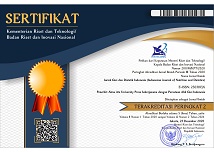Nutrient content, antioxidant activity, and organoleptic quality of coriander seeds (Coriandrum sativum L.) and white ginger (Zingiber officinale Rosc.) tea bags as functional drinks for hypertension
Abstract
Background: High blood pressure prevalence in Indonesia increased to 34.1% in 2018. High blood pressure can be caused by an unhealthy diet, including high sodium intake. Therefore, potassium and antioxidant intake are needed to lower blood pressure.
Objectives: Analyzing the nutritional quality (moisture content, ash content, potassium content, and antioxidant activity) and organoleptic quality (colour, aroma, and taste) of coriander seeds and white ginger tea bags as functional drinks for hypertension.
Methods: The study used experimental research with Completely Randomized Design (CRD) using three treatment levels and three repetitions with ratio of coriander seeds and white ginger used in this study is P1 (55:45), P2 (50:50), and P3 (45:55). Determinating organoleptic quality using hedonic and descriptive, water content using oven method, ash content using incineration method, potassium content using calculated value, and antioxidant activity using DPPH method.
Results: Moisture content, ash content, and potassium content of each coriander seed and white ginger tea bag formulation have met the standards. The IC50 values in each coriander seed and white ginger tea bag indicate very strong antioxidant properties. Organoleptic quality results for colour indicate that P2 (50:50) has the highest value and significantly differs from P1 (55:45) and P3 (45:55) (p-value < 0.05), while for aroma and taste, P2 (50:50) has the highest value but no significant difference was observed (p-value>0.05).
Conclusion: The best formulation of coriander seeds and white ginger tea bags as a functional drink for hypertension is P2 (50:50).
Keywords
Full Text:
PDFReferences
Badan Penelitian dan Pengembangan Kesehatan. (2018). Laporan Riskesdas 2018 Nasional. https://repository.badankebijakan.kemkes.go.id/id/eprint/3514.
Dinas Kesehatan Provinsi Jawa Timur. (2022). Profil Kesehatan 2021.
Fitri, Y., Rusmikawati, R., Zulfah, S., & Nurbaiti, N. (2018). Asupan Natrium dan Kalium sebagai Faktor Penyebab Hipertensi pada Usia Lanjut. AcTion: Aceh Nutrition Journal, 3(2), 158.
Rohatin, A., & Prayuda, C. W. (2020). Hubungan Asupan Natrium, Kalium dengan Hipertensi Pada Lansia di Poliklinik Penyakit Dalam. In Jurnal Fakultas Ilmu Kesehatan (Vol. 1, Issue 1).
Kurniadi, H., & Nurrahmani, U. (2017). Stop! Gejala Penyakit Jantung Koroner, Kolesterol Tinggi, Diabetes Melitus, Hipertensi. Istana Media.
Afifah, L. N. (2019). Aplikasi Rebusan Biji Ketumbar (Coriandrum sativum) sebagai Penurun Tekanan Darah pada Lansia dengan Hipertensi. Universitas Muhammadiyah Magelang.
Rahmah, T. (2021). Pengaruh Pemberian Rebusan Ketumbar terhadap Hipertensi pada Ibu Menopause di Wilayah Kerja Puskesmas Margorejometro Selatan. Poltekkes Tanjungkarang.
Persatuan Ahli Gizi Indonesia. (2018). Tabel Komposisi Pangan Indonesia. Elex Media Komputindo.
Widiasari, S. (2018). Inhibition Angiotensin Converting Enzym Mechanism by Flavonoid In Hypertension. In Collaborative Medical Journal (CMJ) (Vol. 1).
Tamrin, Retno N, D., & Muawanah, S. (2015). Pengaruh Ekstrak Jahe terhadap Penurunan Tekanan Darah pada Lansia dengan Hipertensi di RW 03 Kelurahan Tambangan. Jurnal NERS Widya Husada, 2(2).
Kristiani, R. B., & Ningrum, S. S. (2021). Pemberian Minuman Jahe Terhadap Tekanan Darah Penderita Hipertensi Di Posyandu Lansia Surya Kencana Bulak Jaya Surabaya. Adi Husada Nursing Journal, 6(2), 117. https://doi.org/10.37036/ahnj.v6i2.180
Andini, D. R., Yusasrini, N. L. A., & Darmayanti, L. P. T. (2023). Pengaruh Penambahan Bubuk Jahe Emprit (Zingiber Officinale Var. Amarum) Terhadap Karakteristik Teh Herbal Daun Sirih Merah (Piper Crocatum). Jurnal Ilmu Dan Teknologi Pangan (ITEPA), 12(2), 236–249.
Septiwi, R. E., Ratnasari, D., & Handayani, R. P. (2019). Pembuatan Sediaan Teh Celup Daun Salam (Syzygium polyanthum) dengan Penambahan Rimpang Jahe Merah (Zingiber officinale Rosc. Var. Rubrum) untuk Kesehatan. Journal of Holistic and Health Sciences, 3(1), 46–53.
Nazir, M., Arif, S., Khan R S, Nazir W, Khalid N, & Maqsood S. (2019). Opportunities and challenges for functional and medicinal beverages: Current and future trends. Trends in Food Science & Technology, 88, 513–526.
Dinanti, M. V. (2016). Pemeriksaan Kadar Mineral Kalium, Kalsium, dan Magnesium Air Seduhan Teh Daun Sirsak (Anonna muricata L.) dalam Kemasan Secara Spektrofotometri Serapan Atom.
Siagian, I. D. N., Bintoro, V. P., & Nurwantoro. (2020). Karakteristik Fisik, Kimia dan Organoleptik Teh Celup Daun Tin degan Penambahan Daun Stevia (Stevia Rbaudiana B.) sebagai Pemanis. Jurnal Teknologi Pangan, 4(1), 23–29.
Balasooriya, R., Kooragoda, M., & Jayawardhane, P. (2019). Comparative Analysis on Physical and Chemical Characteristics of Commercially Manufactured/processed Green Tea in Sri Lanka. International Journal of Food Science and Nutrition, 4(4), 43–47.
The Tea Council of Canada. (2023). Serving sizes and reference amounts. https://inspection.canada.ca/food-labels/labelling/industry/nutrition-labelling/nutrition-facts-table/eng/1389198568400/1389198597278?chap=2
de Abreu, D. B. V., Picard, K., Klein, M. R. S. T., Gadas, O. M., & Richard, C. (2023). Soaking to Reduce Potassium and Phosphorus Content of Foods. Journal of Renal Nutrition, 33(1), 165–171.
Badan Pengawas Obat dan Makanan. (2022). Peraturan Badan pengawas Obat dan makanan Nomor 1 Tahun 2022 tentang Pengawasan Klaim pada Label dan Iklan Pangan Olahan.
Martinez-Morales, F., Alonso-Castro, A. J., Zapata-Morales, J. R., Carranza-Álvarez, C., & Aragon-Martinez, O. H. (2020). Use of standardized units for a correct interpretation of IC50 values obtained from the inhibition of the DPPH radical by natural antioxidants. Chemical Papers, 74(10), 3325–3334.
Pebiningrum, A., Kusnadi, J., & Rif’ah, H. I. (2017). Pengaruh Varietas Jahe (Zingiber officinale) dan Penambahan Madu terhadap Aktivitas Antioksidan Minuman Fermentasi Kombucha Jahe. Journal of Food and Life Sciences, 1(2).
Khetrapal, A. (2021). The Genetics of Coriander’s Soapy Taste. https://www.news-medical.net/health/The-Genetics-of-Corianders-Soapy-Taste.aspx#:~:text=Through%20these%20studies%2C%20scientists%20were,leaves%20as%20well%20as%20soaps.
Firdausni, F. (F), & Kamsina, K. (K). (2018). Pengaruh Pemakaian Jahe Emprit dan Jahe Merah terhadap Karakteristik Fisik, Total Fenol, dan Kandungan Gingerol, Shogaol Ting-ting Jahe (Zingiber Officinale). Indonesian Journal of Industrial Research, 8(2), 67–76. https://doi.org/10.24960/JLI.V8I2.4330.67-76
Dewata, I. P., Ari Sandhi W, P., & Widarta, I. W. R. (2017). Pengaruh Suhu dan Lama Penyeduhan terhadap Aktivitas Antioksidan dan Sidat Sensoris Teh Herbal Daun Alpukat (Persea americana Mill). Jurnal Ilmu Dan Teknologi Pangan (ITEPA), 6(2), 30–39.
DOI: http://dx.doi.org/10.21927/ijnd.2025.13(1).70-77
Refbacks
- There are currently no refbacks.

This work is licensed under a Creative Commons Attribution-ShareAlike 4.0 International License.
Indonesian Journal of Nutrition and Dietetics (IJND) indexed by:
 View My Stats
View My Stats



12.png)


























